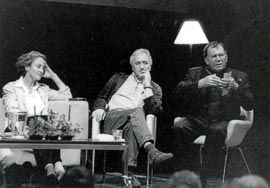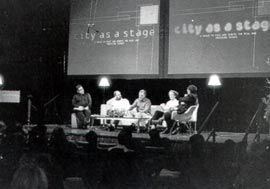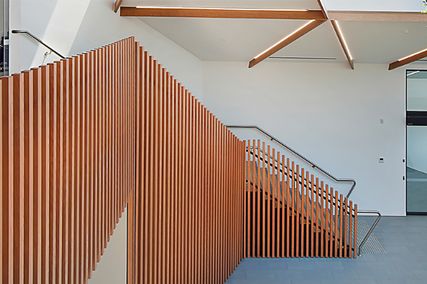
Elizabeth Farrelly, Charles Landry and Jan Gehl.

Photos Ian Routledge.
City as a Stage
was a public forum to ›› explore “the changing role of cities and the ›› issues and challenges they face in the new ›› millennium”. Held in Adelaide on 2-3 March, ›› it was the first of a series of events that will ›› lead up to next year’s Adelaide Festival of ›› the Arts. Peter Sellars, the Festival’s director, ›› has chosen to give it an urban flavour.
Perhaps I should begin by stating that I ›› had a special view of this conference. As a ›› City of Adelaide councillor, I probably took ›› remarks like Peter Verwer’s “Why is Adelaide ›› so ugly? It’s a renovator’s dream” more ›› personally than others, and I was probably ›› also more interested in particular panaceas ›› for Adelaide than the more disinterested ›› attendee. Because of, or in spite of, my ›› position I found the conference thoroughly ›› stimulating. It was my impression that many ›› of the audience – all 500 of them at each ›› session – were also engaged and excited by ›› most of the sessions.
Two keynote presentations were given at ›› either end of the conference. These ›› demonstrated its arrangement from general ›› concerns to particular designs. Herbert ›› Girardet spoke of the city as an ›› environmental system with an “ecological ›› footprint” – an ecological footprint being the ›› area required to sustain a city using present ›› technologies and resources. The statistics ›› are grim: London currently requires 125 ›› times its own surface area to sustain it, and ›› in 20 years the growth of cities may require ›› the area of three planets to sustain them.
At the other end of the scale, Jan Gehl ›› described devices for creating pleasant and ›› appropriate urban environments. He spoke ›› about walking as the key to liveable cities ›› and the ways in which a well-designed city ›› can encourage people to pause and enjoy ›› their urban environment, including providing ›› for “bench flirts” – those who wish to make ›› casual contacts as part of city life.
He classified cities into three states:
The City Invaded, The City Abandoned and ›› The City Reconquered. The first is a city that ›› has been taken over by cars, where the ›› ability to walk in dignity has been lost; the ›› second, a worse stage, is where the city ›› has become deserted, and the third is ›› where the city is rehabilitated with small ›› interventions, creating “pocket life”. He ›› drew on the successful examples described ›› in his book New City Spaces, describing ›› eight cities that are doing their job well, ›› including Melbourne.
In between, notable contributions were ›› made by several other speakers. Beatrix ›› Campbell administered a tart antidote to ›› those who are nostalgic about past ›› communities and those who relay fuzzy ›› contemporary concepts. For her, ›› communities are places which resource the ›› space of the community. Such a definition ›› allows a re-examination of the concept and ›› provides the basis for a critique of current ›› rhetoric. For instance, in the past, as now, ›› one can point to exclusions of access. Men ›› have been able to exclude in a drama of ›› power and powerlessness that has gender ›› implications; they often control movement in ›› streets. The poor are also disadvantaged.
Why then, she asked, according to common ›› parlance, do only the poor live in ›› communities? In these circumstances ›› “community” is only an illusion of ›› homogeneity. Further, if “community” is used ›› as a political fetish to infer a law-abiding, ›› policed community then “community” is a ›› dangerous word.
Bill Mitchell addressed the underlying ›› fear that cities may become irrelevant in the ›› computer age. That was not his view. He ›› pointed out that cities have consistently ›› relied on systems of communication and ›› technology – the nervous systems of cities.
He noted the historical progression from the ›› Greek agora, the growing reticulation of ›› services in the nineteenth century and the ›› twentieth century development of digital ›› communication. He saw the twenty-first ›› century as having the potential for greater ›› democratisation through new patterns of ›› work and the ability to employ mass ›› customisation rather than relying on mass ›› production. On the down side, there is ›› currently no intersection between the ›› dot.com world and the discourses of ›› sustainability.
One could contrast Peter Verwer’s and ›› John Montgomery’s presentations. Both ›› were concerned with the effectiveness of ›› cities at doing their job: Peter Verwer ›› defined it in terms of economic ›› competitiveness and John Montgomery in ›› terms of enhancing liveability. Both ›› recognised the imperative of being smarter ›› to achieve their ends. I enjoyed John ›› Montgomery’s characterisation of a city as a ›› place where a degree of anonymity means ›› that “one can be a wee bit naughty”.
Contrasting the two presentations would ›› overlook the fact that both speakers ›› realised that cities compete and both ›› described space/place design as ›› consequently being important. Neither ›› thought Adelaide was performing well. Peter ›› Sellers’ up beat exhortations for Adelaide to ›› take off and to exert its collective energy ›› followed. Stirring stuff.
Greg Burgess demonstrated his individual ›› skill in place-making and Alison Page and ›› John Mongard discussed their approaches ›› to practices in the same field. Greg, Alison ›› and Lewis O’Brien, a well-respected Kaurna ›› elder, addressed Aboriginal place making ›› and its essential role in characterising ›› Australia and furthering the process of ›› reconciliation.
It is on this note I have to end, realising ›› that among others Ken Maher’s sensitive ›› analysis of the nature of Australian cities ›› and Elizabeth Farrelly’s and Catherin ›› Bull’s equally sensitive descriptions of ›› the processes of place-making have been ›› neglected. I can only reiterate that I ›› enjoyed it all.
Judith Brine is a city councillor and associate vice chancellor of the University of Adelaide.















